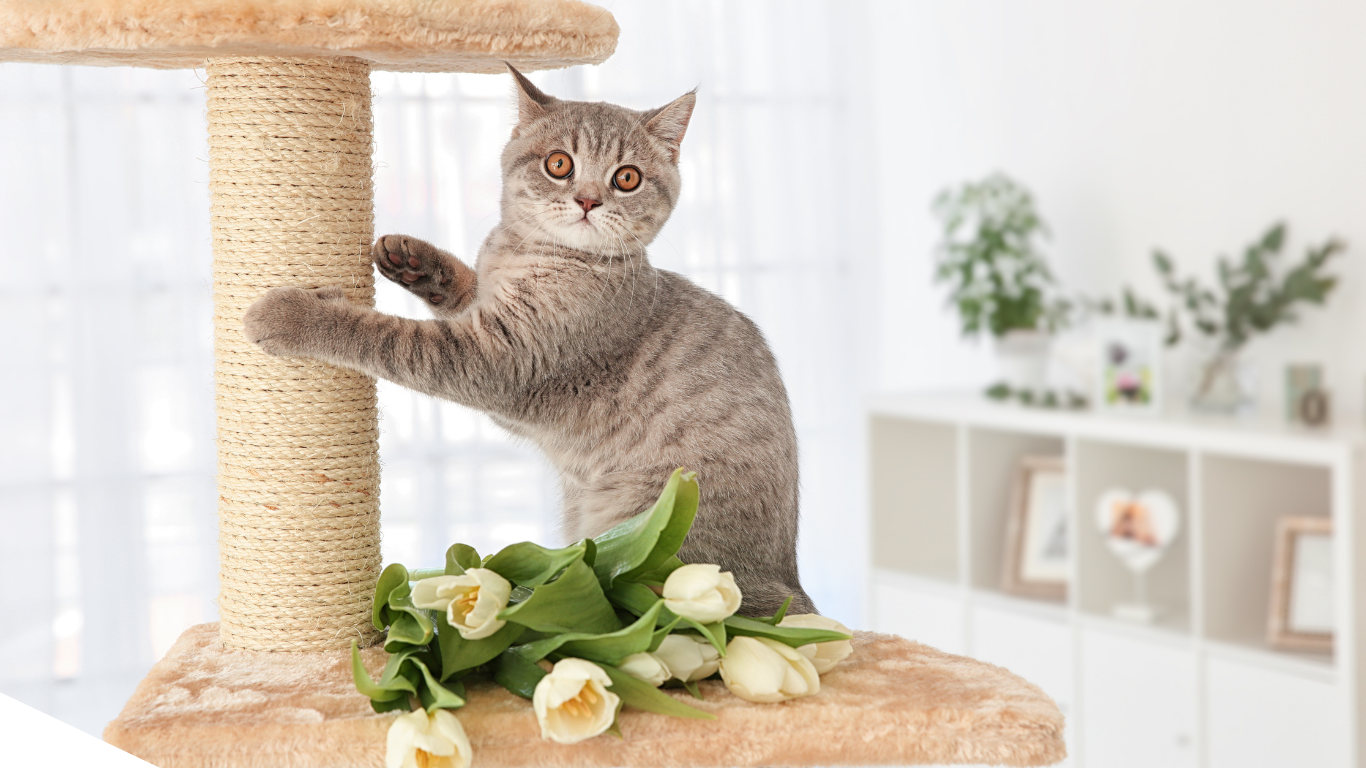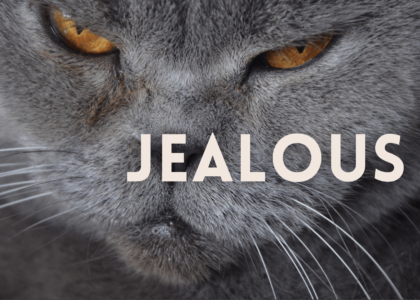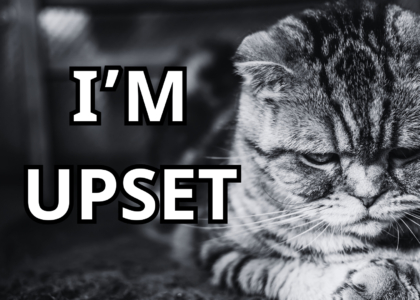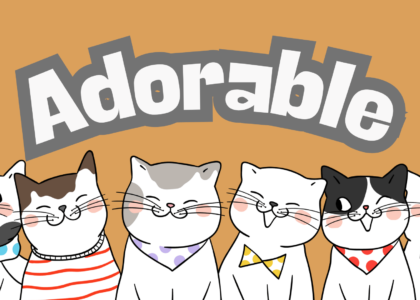I. Introduction
If you have a large cat, you already know they need extra space to stretch, climb, and lounge comfortably. While standard cat towers might work for smaller breeds, they often fall short when it comes to supporting the weight and size of a big cat. A flimsy or undersized cat tree can wobble, tip over, or simply be too cramped, leaving your feline friend frustrated and uninterested.
That’s why choosing the right cat tower for a large cat is essential—not just for their enjoyment but also for their safety. A well-designed cat tower provides a secure space for climbing, scratching, and relaxing while helping prevent boredom and destructive behavior. But with so many options on the market, how do you know which one is best?
In this guide, we’ll walk you through everything you need to consider when shopping for a sturdy and spacious cat tower. We’ll explore key features like weight capacity, stability, and materials, and we’ll review some of the top-rated cat towers designed specifically for larger breeds. Whether you have a Maine Coon, Ragdoll, or another big cat, by the end of this article, you’ll have all the information you need to make the best choice for your furry companion.
II. Why Large Cats Need a Special Cat Tower
Not all cat towers are created equal—especially when it comes to accommodating large cats. If you’ve ever watched your big feline attempt to perch on a tiny platform or squeeze into a cramped cubby, you know the struggle is real. Many standard cat trees are designed with average-sized cats in mind, meaning they lack the necessary space, support, and durability that a large breed requires.
1. Standard Cat Towers Are Too Small
One of the biggest issues with regular cat towers is size. Large cats like Maine Coons, Ragdolls, and Norwegian Forest Cats can easily weigh 15 pounds or more, with some reaching up to 25 pounds. Most standard cat trees have small platforms and condos that simply don’t offer enough room for these big felines to stretch out comfortably. A cat tower that is too cramped may discourage your cat from using it altogether, leading them to seek out alternative (and sometimes less ideal) lounging spots—like your furniture.
2. Stability is a Major Concern
A large cat needs a cat tower that can handle their weight without wobbling or tipping over. Many budget-friendly cat trees are made from lightweight materials like particleboard, which can struggle to support heavier cats. When a structure isn’t stable, it can make your cat feel unsafe, and they may avoid using it. Worse yet, an unstable tower could topple over, posing a risk of injury to both your cat and anyone nearby.
3. The Importance of Durable Materials
Bigger cats put more stress on their cat towers—not just from their weight but also from their natural scratching and jumping behaviors. A cheaply made cat tree with thin scratching posts and flimsy platforms won’t last long under the pressure of a large cat. To withstand daily use, a tower designed for larger breeds should feature strong materials like solid wood, reinforced sisal scratching posts, and high-quality carpeting or plush fabric.
4. Large Cats Need Taller and Thicker Scratching Posts
Scratching is a natural behavior that helps cats stretch, mark their territory, and maintain healthy claws. Unfortunately, many standard cat towers have scratching posts that are too short or thin for large cats. A big feline needs a post tall enough for a full-body stretch and sturdy enough to handle their strength. Thick, reinforced sisal posts are a must-have for any cat tower intended for a larger breed.
5. Comfort and Accessibility Matter
Cats love to curl up in cozy spots, but small hammocks and enclosed condos can be uncomfortably tight for a large cat. If a lounging area is too small, your cat may feel restricted and choose to sleep elsewhere. Spacious perches, cushioned platforms, and large entryways to enclosed spaces are key features that make a cat tower inviting for a big cat.
6. Encouraging Exercise and Climbing
Despite their size, large cats still have the same instincts as their smaller counterparts—they love to climb, jump, and explore vertical spaces. A well-designed cat tower should offer multiple levels that are easy to navigate without being too steep or unstable. Giving your large cat an engaging, safe space to climb can help keep them active and reduce boredom, which is especially important for indoor cats.
Investing in a cat tower that is specifically built for large cats is about more than just comfort—it’s about safety, durability, and overall well-being. A well-constructed, spacious cat tree allows your big feline to climb, scratch, and relax without limitations. In the next section, we’ll go over the most important features to look for when choosing the best cat tower for your large cat.
III. Key Features to Look for in a Cat Tower for Large Cats
Choosing the right cat tower for a large cat requires more than just picking the tallest or most aesthetically pleasing option. Large cats need a tower that is strong, spacious, and designed to support their weight and activity levels. Below are the most important features to consider when selecting a cat tree that will keep your big feline both comfortable and safe.
1. Sturdiness & Stability
Large cats require a solid, well-balanced tower that won’t wobble or tip over when they jump onto it. Stability is one of the most crucial factors to consider, as a shaky cat tree can discourage your cat from using it—or worse, pose a safety risk.
What to Look For:
- A wide and heavy base to prevent tipping
- Solid wood or reinforced construction (avoid flimsy particleboard)
- Wall-mounting options for added security in extra-tall models
2. Weight Capacity & Size
Many cat towers list a weight limit, but it’s important to ensure that not just the base, but also the perches, platforms, and condos can handle a large cat. If the listed capacity isn’t clear, check customer reviews from owners of large breeds.
What to Look For:
- A minimum weight capacity of 15-25 lbs per perch
- Spacious platforms (at least 18 inches wide)
- Large entryways to condos (avoid tight openings meant for small cats)
3. Comfortable & Spacious Design
Cats love to lounge, but standard-sized perches and cubbies are often too cramped for bigger felines. Look for a cat tree with ample resting space where your cat can fully stretch out.
What to Look For:
- Oversized perches and hammocks designed for large cats
- Plush, high-quality cushioning for comfort
- Multiple spacious resting areas to accommodate different lounging preferences
4. Scratching Posts & Durable Sisal Material
Scratching is an instinctive behavior, and large cats need sturdy scratching posts that can handle their strength. A poorly made post will wear out quickly and may even tip the tower over if it’s too light.
What to Look For:
- Extra-thick scratching posts (at least 3-4 inches in diameter)
- Tightly wrapped sisal rope for durability
- Taller posts (at least 30 inches) to allow a full stretch
5. Multi-Level Layout for Climbing & Play
Cats love vertical spaces, and a multi-level tower encourages natural climbing behavior. However, the structure must be designed with stability in mind—too many high, narrow platforms can be dangerous for a large cat.
What to Look For:
- Gradual height increases for easy climbing
- Strong, well-supported levels that won’t collapse under pressure
- Spacious step-like platforms instead of tight, vertical jumps
6. Ease of Assembly & Maintenance
A high-quality cat tower should be easy to put together and maintain over time. Large cats put extra stress on furniture, so having replaceable or easy-to-clean materials will extend the life of the tower.
What to Look For:
- Simple assembly with sturdy connectors
- Replaceable cushions or covers
- Easy-to-clean materials like faux fleece or wood surfaces
7. Safe and Non-Toxic Materials
Since cats often chew or lick their surroundings, it’s important to choose a cat tower made from pet-safe materials. Avoid towers with low-quality adhesives, treated woods, or cheap fabrics that could be harmful.
What to Look For:
- Natural wood or high-quality engineered wood (avoid formaldehyde-treated particleboard)
- Non-toxic, pet-safe finishes
- Soft, durable fabric that doesn’t shed easily
Finding the right cat tower for a large cat means prioritizing strength, comfort, and functionality. A well-built tower will not only provide your big cat with a safe and enjoyable space but will also last much longer than a cheaply made alternative. In the next section, we’ll review the top cat towers that meet these criteria and are highly rated by owners of large cats.
IV. Top 5 Best Cat Towers for Large Cats (With Pros & Cons)
Choosing the best cat tower for a large cat means prioritizing stability, weight capacity, spacious design, and durability. Below are five top-rated cat towers designed specifically for large breeds like Maine Coons, Ragdolls, and Norwegian Forest Cats. These options offer sturdy construction, ample lounging space, and multiple scratching areas to keep your big feline happy and engaged.
1. Globlazer S72 Heavy Duty Cat Tree for Large Cats (72 Inches Tall)
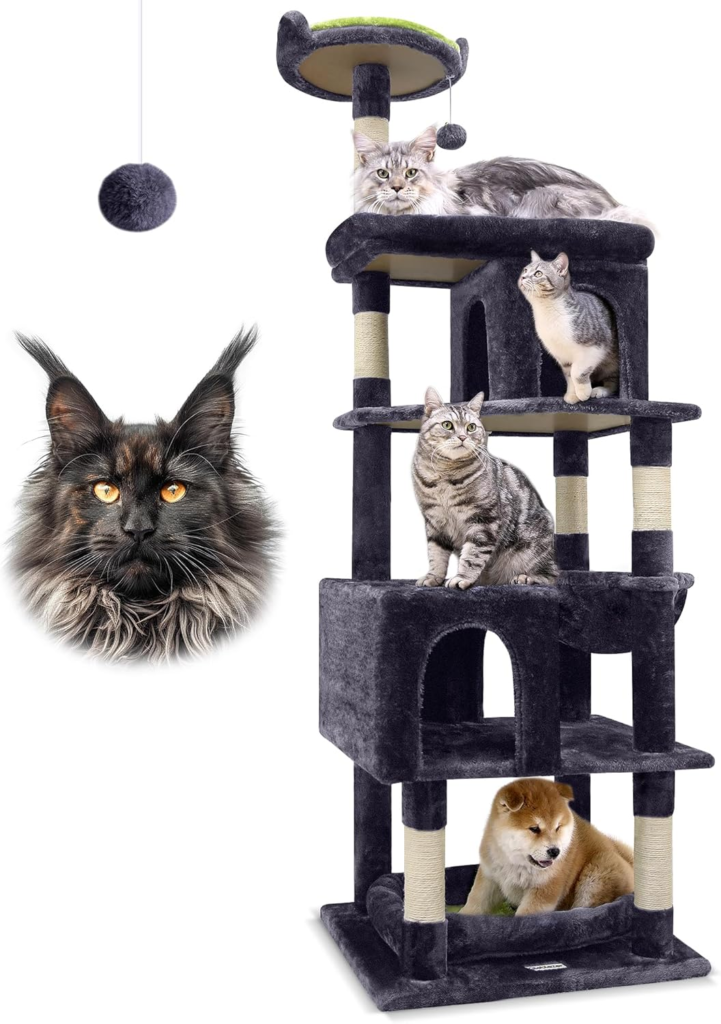
Best for: Multi-cat households with large cats who love to climb
The Globlazer S72 Heavy Duty Cat Tree is a powerhouse designed for extra-large cats (20+ lbs). At 72 inches tall, this cat tree provides plenty of climbing opportunities while ensuring stability with a reinforced base and heavy-duty construction. The extra-thick scratching posts and spacious perches make it perfect for big cats who love to stretch and relax at different heights.
✅ Pros:
✔ Extremely sturdy and designed specifically for large cats (20+ lbs)
✔ Extra-large platforms and perches for comfortable lounging
✔ 6 thick scratching posts covered in sisal for durability
✔ Includes a reinforced hammock that can support heavier cats
✔ Provides multiple climbing levels for active cats
❌ Cons:
✖ Takes up a large footprint, requiring ample space
✖ Can be challenging to assemble due to its height
✖ Not ideal for very senior cats who struggle with climbing
2. SHA CERLIN 68-Inch Multi-Level Large Cat Tree
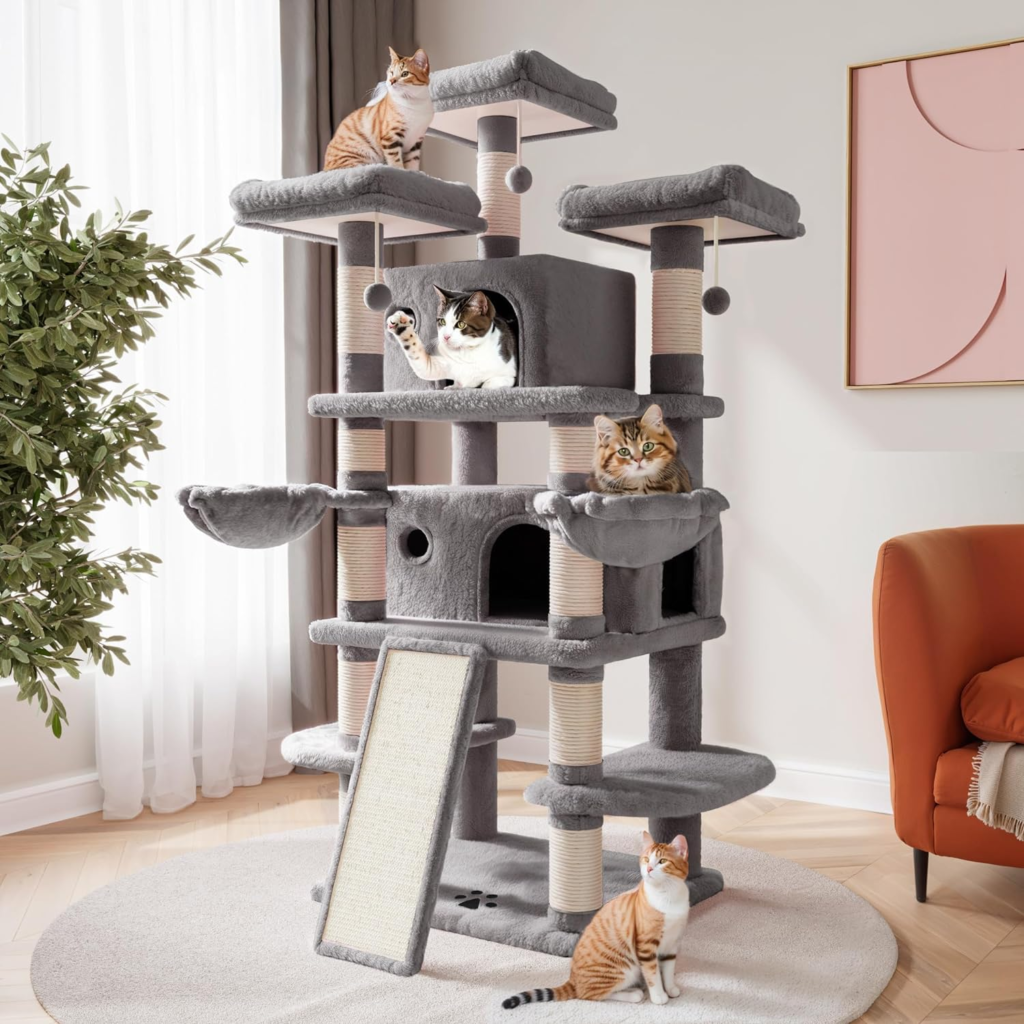
Best for: Cats who love cozy perches and hammocks
The SHA CERLIN 68-Inch Cat Tower is built for large kitties who enjoy lounging in soft, plush perches. This model features two spacious condos, multiple perches, and hammocks that provide a variety of cozy resting spots. It’s sturdy, well-balanced, and covered in plush fabric, making it an excellent option for both playful and lazy cats.
✅ Pros:
✔ Large, soft perches for comfortable lounging
✔ Two spacious condos ideal for big cats to hide and relax
✔ Sturdy sisal-covered scratching posts to promote healthy claw maintenance
✔ Well-balanced multi-level design for climbing and play
✔ Hammocks included, which are reinforced to support heavier cats
❌ Cons:
✖ Some users report that the hammocks may sag over time
✖ Assembly can be time-consuming
✖ The perches, while soft, may be too small for cats over 20 lbs
3. Yaheetech 63-Inch Large Multi-Level Cat Tree
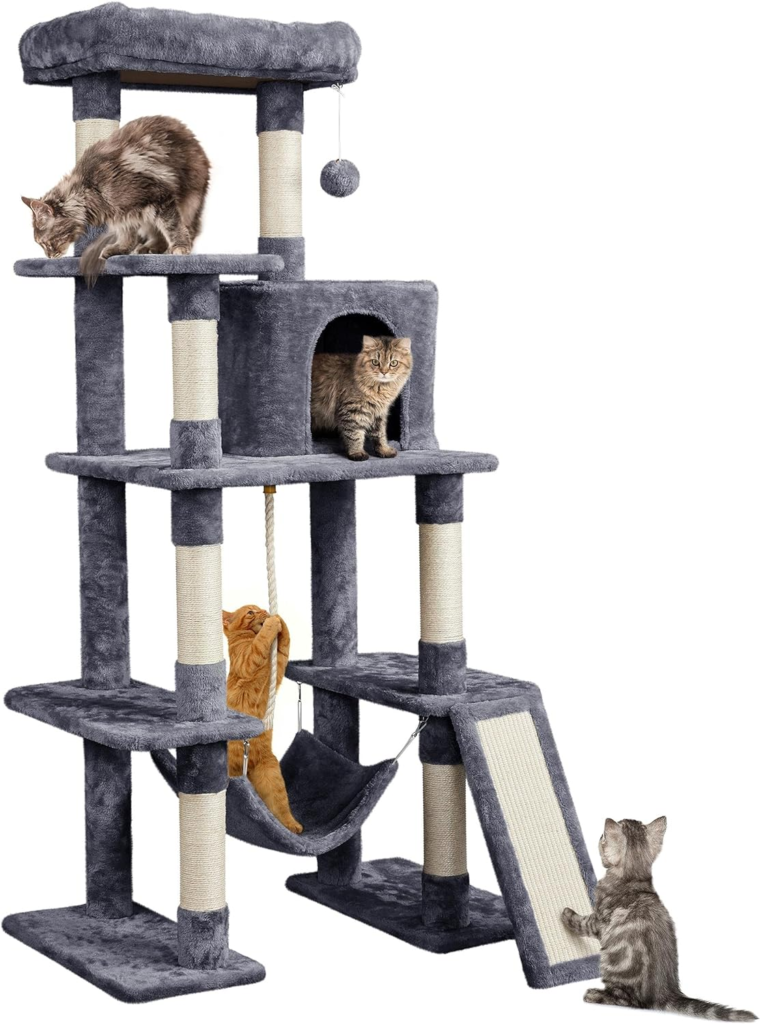
Best for: Budget-conscious cat owners looking for a solid, multi-level tree
The Yaheetech 63-Inch Multi-Level Cat Tree is an affordable yet sturdy and feature-packed choice for large cats. It comes with sisal-covered scratching posts, a spacious condo, a hammock, and a dangling ball toy for extra entertainment. Despite being budget-friendly, it holds up well for larger cats, thanks to its well-balanced design.
✅ Pros:
✔ Affordable compared to other large cat towers
✔ Multiple levels to accommodate more than one cat
✔ Includes a hammock, extended platforms, and a large condo
✔ Thick scratching posts wrapped in sisal to handle heavy use
✔ Compact design is great for small apartments
❌ Cons:
✖ Not as heavy-duty as premium models (best for cats under 20 lbs)
✖ The perches and hammock are smaller, making it less ideal for very large cats
✖ Sisal wrapping may wear down faster compared to higher-end models
Final Verdict: Which Cat Tower is Best?
- 🏆 Best Overall: Globlazer S72 Heavy Duty Cat Tree – Best for large, active cats who love climbing and scratching.
- 💰 Best Budget Option: Yaheetech 63-Inch Cat Tree – Great for large cats, but more affordable than premium models.
- 🛋 Best for Comfort: SHA CERLIN 68-Inch Cat Tower – Ideal for cats who love hammocks and plush lounging spots.
The best cat tower for your large cat depends on their personality, activity level, and space requirements. If your cat loves to climb, go for a tall, heavy-duty option like the Globlazer S72 Heavy Duty Cat Tree. If they prefer lounging, the SHA CERLIN 68-Inch Cat Tower or might be the best fit. If you are on a budget then go for the Yaheetech 63-Inch Cat Tree.
No matter which one you choose, investing in a high-quality, sturdy cat tower will keep your big feline happy, comfortable, and entertained for years to come.
V. How to Choose the Best Cat Tower for Your Large Cat
With so many cat towers on the market, finding the right one for a large cat can feel overwhelming. The key is to look beyond just the aesthetics and focus on stability, size, weight capacity, and overall durability. Below, we’ll walk you through the essential factors to consider when selecting the best cat tower for your big feline.
1. Consider Your Cat’s Size and Weight
Not all cat trees are designed to support large breeds like Maine Coons, Ragdolls, or Norwegian Forest Cats. Many standard towers are too small or flimsy, making them unsafe for heavier cats.
💡 What to Look For:
✔ Weight capacity of at least 20 lbs per level
✔ Platforms 18 inches or wider for comfortable lounging
✔ Spacious condos and perches that allow your cat to stretch out
2. Prioritize Stability and Sturdiness
A wobbly cat tower is a safety hazard, especially for larger cats who jump with more force. If a tower isn’t stable, your cat may avoid using it entirely.
💡 What to Look For:
✔ Wide, heavy base to prevent tipping
✔ Solid wood or reinforced engineered wood (avoid lightweight particleboard)
✔ Thick support columns and sturdy screws for secure assembly
✔ Wall-mounting options for extra stability (especially for tall cat trees)
🚨 Avoid: Cheap, lightweight cat trees that may collapse under your cat’s weight.
3. Ensure There’s Enough Space for Lounging
Large cats need roomy perches, condos, and hammocks that won’t feel cramped. If a cat tower is too small, your cat may ignore it completely.
💡 What to Look For:
✔ Oversized perches (18”+ width) to accommodate stretched-out lounging
✔ Large, spacious condos with wide openings (not tight entryways)
✔ Reinforced hammocks that can support heavier cats
🚨 Avoid: Small cubbies and hammocks that are too tight for a big cat to fit comfortably.
4. Look for High-Quality Scratching Posts
Scratching is essential for claw health, and large cats need extra-thick, tall scratching posts to accommodate their size.
💡 What to Look For:
✔ Sisal-wrapped posts that are at least 3-4 inches thick
✔ Tall posts (30”+) that allow for full-body stretching
✔ Multiple scratching areas throughout the cat tree
🚨 Avoid: Thin, short scratching posts that won’t withstand heavy use.
5. Choose a Tower With a Multi-Level Layout
Cats love climbing, and a multi-level cat tree encourages exercise, exploration, and vertical movement. However, the structure should allow easy access without steep or unstable jumps.
💡 What to Look For:
✔ Multiple levels with gradual height transitions
✔ Wide, well-supported platforms for safe movement
✔ Enclosed spaces and open perches for variety
🚨 Avoid: Tall towers with narrow, unstable platforms that are hard to reach.
6. Consider Ease of Assembly and Maintenance
A high-quality cat tree should be easy to assemble, clean, and maintain over time. Since large cats put more strain on furniture, choose a design with replaceable parts when possible.
💡 What to Look For:
✔ Simple assembly with secure screws and reinforcements
✔ Removable, washable cushions for hygiene
✔ Scratch-resistant materials to extend the life of the tower
🚨 Avoid: Complicated assembly processes and materials that are difficult to clean.
7. Match the Cat Tower to Your Living Space
While it’s important to get a tower large enough for your cat, it also needs to fit well in your home.
💡 What to Consider:
✔ For small spaces: Choose a compact, vertical design
✔ For multi-cat homes: Opt for a wide, multi-level tower with multiple perches
✔ For modern aesthetics: Look for wood or minimalist designs
🚨 Avoid: Oversized cat trees if you don’t have enough floor space for stability.
8. Balance Budget and Quality
While it’s tempting to go for the cheapest option, investing in a high-quality cat tower will save you money in the long run. Cheap cat trees often break quickly, forcing you to replace them sooner.
💡 What to Consider:
✔ A well-built, high-quality tower will last years
✔ Look at customer reviews to gauge durability
✔ Check for warranty or return policies for peace of mind
🚨 Avoid: Bargain cat trees made with weak particleboard that deteriorates fast.
Choosing the right cat tower for your large cat is all about stability, space, and durability. A good cat tree should be sturdy enough to handle their weight, spacious enough for lounging, and engaging enough to encourage climbing and scratching.
Quick Recap – What to Prioritize:
✅ Weight capacity – At least 20 lbs per level
✅ Stable base – Wide, heavy base for no wobbling
✅ Spacious design – Large perches, condos, and hammocks
✅ Thick scratching posts – At least 3-4 inches wide, 30+ inches tall
✅ Multi-level layout – Easy climbing without steep jumps
✅ Durability – Solid wood or high-quality engineered wood
By investing in the right cat tower, you’re giving your large feline a safe, fun, and comfortable space they’ll love for years to come.
VI. Frequently Asked Questions (FAQs)
When choosing the best cat tower for a large cat, many pet owners have similar concerns about stability, materials, and usability. Below, we’ve compiled answers to some of the most frequently asked questions to help you make the best choice for your feline friend.
1. How do I make sure my cat tower is stable enough for a large cat?
✅ Choose a tower with a wide, heavy base – The larger the base, the less likely it is to tip over.
✅ Opt for solid wood construction – Avoid flimsy particleboard, which can break under weight.
✅ Position it against a wall or in a corner for added support.
✅ Use wall anchors or secure brackets for extra stability, especially for tall cat trees.
2. What’s the best material for a durable cat tower?
The best cat towers for large cats should be made from sturdy, high-quality materials that can handle heavy use.
- Best choices: Solid wood, plywood, or reinforced engineered wood (for durability).
- Good scratching material: Sisal rope (lasts longer than cardboard or fabric).
- For comfort: Plush fabric, faux fleece, or carpeted surfaces (soft for lounging).
🚨 Avoid: Thin, low-density particleboard, as it can break under pressure.
3. What size perches and condos should I look for?
Large cats need spacious platforms, perches, and condos to rest comfortably.
- Perches: At least 18 inches wide for proper support.
- Condos: Should have wide openings (10-12 inches) and spacious interiors for easy entry.
- Hammocks: Only if they are reinforced and designed for heavier cats.
4. What is the best height for a cat tower?
- If your cat loves climbing, go for a tall multi-level tower (60-72 inches).
- If your cat is less active or a senior, a shorter tower (30-50 inches) with easy access is best.
- Wall-mounted options are great for vertical climbers but should be securely installed.
5. Can large cats safely use hammocks in cat towers?
Yes, but only if the hammock is reinforced with strong fabric and secure mounting.
🔹 Look for weight-tested hammocks (rated for 20+ lbs).
🔹 Avoid small or loosely attached hammocks, as they may sag or detach.
🔹 Check reviews to see if owners of large cats have tested the hammock’s durability.
6. How do I encourage my cat to use a new cat tower?
If your cat seems hesitant to use the new tower, try these tricks:
🐾 Place the tower near their favorite sleeping or play area.
🐾 Use catnip or treats to create a positive association.
🐾 Play with toys on the tower to encourage exploration.
🐾 Rub a soft cloth on your cat and then on the tree to transfer their scent.
🐾 Make sure the tower is stable—if it wobbles, they may avoid it.
7. Do large cats need ramps in their cat towers?
Ramps can be helpful for senior cats, overweight cats, or cats with mobility issues.
✅ Choose a tower with gradual climbing platforms if your cat struggles with high jumps.
✅ Look for wide, carpeted ramps for better traction.
✅ Healthy, active large cats may not need ramps, as they can jump between levels.
8. How often should I replace my cat tower?
A high-quality cat tower should last several years if well-maintained.
🔹 Signs it’s time to replace:
- Wobbly or broken platforms that can’t be reinforced.
- Heavily worn scratching posts with sisal rope peeling off.
- Torn or unsafe fabric that poses a choking hazard.
- Your cat has outgrown it and no longer fits comfortably.
9. What’s the best cat tower for a Maine Coon?
Maine Coons are one of the largest domestic cat breeds, so they need an extra-sturdy cat tower.
- Best features for a Maine Coon:
✔ Heavy-duty wood construction for weight support
✔ Extra-large perches and condos (18-24 inches wide)
✔ Tall scratching posts (30+ inches) for a full stretch
✔ A secure, reinforced base to prevent wobbling
💡 Top Pick: The S72 Heavy Duty Cat Tree for Large Cats (🔗 Available on Amazon).
When shopping for a cat tower for a large cat, the key is stability, spacious design, and durability. Make sure the structure can support your cat’s weight and activity level.
VIII. Conclusion
Finding the best cat tower for a large cat requires more than just picking the tallest or most stylish option—it’s about stability, durability, and comfort. Large cats like Maine Coons, Ragdolls, and Norwegian Forest Cats need a sturdy, well-balanced structure that can handle their weight while providing ample space for lounging, climbing, and scratching.
Key Takeaways:
✔ Prioritize stability – A wide, heavy base and solid wood construction prevent wobbling.
✔ Choose spacious platforms and perches – At least 18 inches wide to support larger bodies.
✔ Look for durable scratching posts – Thick, sisal-wrapped posts (3-4 inches in diameter) are ideal.
✔ Consider your cat’s activity level – Tall towers with multi-level platforms work best for active climbers.
✔ Think long-term – Investing in a high-quality cat tree saves money over time by reducing replacements.
Final Thought:
A well-built cat tower isn’t just a piece of furniture—it’s a safe haven for your cat to climb, play, scratch, and rest. Investing in the right tower will enhance your cat’s physical and mental well-being, while also protecting your furniture from scratching damage.
🐾 Whether you buy or build, the perfect cat tower will keep your big feline happy, healthy, and entertained for years to come! 🐾


